- Home
- Michael Ondaatje
The English Patient Page 11
The English Patient Read online
Page 11
The tent and the dark wood surround them.
They are only a step past the comfort she has given others in the temporary hospitals in Ortona or Monterchi. Her body for last warmth, her whisper for comfort, her needle for sleep. But the sapper’s body allows nothing to enter him that comes from another world. A boy in love who will not eat the food she gathers, who does not need or want the drug in a needle she could slide into his arm, as Caravaggio does, or those ointments of desert invention the Englishman craves, ointments and pollen to reassemble himself the way the Bedouin had done for him. Just for the comfort of sleep.
There are ornaments he places around himself. Certain leaves she has given him, a stub of candle, and in his tent the crystal set and the shoulder bag full of the objects of discipline. He has emerged from the fighting with a calm which, even if false, means order for him. He continues his strictness, following the hawk in its float along the valley within the V of his rifle sight, opening up a bomb and never taking his eyes off what he is searching for as he pulls a Thermos towards him and unscrews the top and drinks, never even looking at the metal cup.
The rest of us are just periphery, she thinks, his eyes are only on what is dangerous, his listening ear on whatever is happening in Helsinki or Berlin that comes over the short-wave. Even when he is a tender lover, and her left hand holds him above the kara, where the muscles of his forearm tense, she feels invisible to that lost look till his groan when his head falls against her neck. Everything else, apart from danger, is periphery. She has taught him to make a noise, desired it of him, and if he is relaxed at all since the fighting it is only in this, as if finally willing to admit his whereabouts in the darkness, to signal out his pleasure with a human sound.
How much she is in love with him or he with her we don’t know. Or how much it is a game of secrets. As they grow intimate the space between them during the day grows larger. She likes the distance he leaves her, the space he assumes is their right. It gives each of them a private energy, a code of air between them when he passes below her window without a word, walking the half-mile to assemble with the other sappers in the town. He passes a plate or some food into her hands. She places a leaf across his brown wrist. Or they work with Caravaggio between them mortaring up a collapsing wall. The sapper sings his Western songs, which Caravaggio enjoys but pretends not to.
‘Pennsylvania six-five-oh-oh-oh,’ the young soldier gasps.
She learns all the varieties of his darkness. The colour of his forearm against the colour of his neck. The colour of his palms, his cheek, the skin under the turban. The darkness of fingers separating red and black wires, or against bread he picks off the gunmetal plate he still uses for food. Then he stands up. His self-sufficiency seems rude to them, though no doubt he feels it is excessive politeness.
She loves most the wet colours of his neck when he bathes. And his chest with its sweat which her fingers grip when he is over her, and the dark, tough arms in the darkness of his tent, or one time in her room when light from the valley’s city, finally free of curfew, rose among them like twilight and lit the colour of his body.
Later she will realize he never allowed himself to be beholden to her, or her to him. She will stare at the word in a novel, lift it off the book and carry it to a dictionary. Beholden. To be under obligation. And he, she knows, never allowed that. If she crosses the two hundred yards of dark garden to him it is her choice, and she might find him asleep, not from a lack of love but from necessity, to be clear-minded towards the next day’s treacherous objects.
He thinks her remarkable. He wakes and sees her in the spray of the lamp. He loves most her face’s smart look. Or in the evenings he loves her voice as she argues Caravaggio out of a foolishness. And the way she crawls in against his body like a saint.
They talk, the slight singsong of his voice within the canvas smell of their tent, which has been his all through the Italian campaign, which he reaches up to touch with his slight fingers as if it too belonged to his body, a khaki wing he folds over himself during the night. It is his world. She feels displaced out of Canada during these nights. He asks her why she cannot sleep. She lies there irritated at his self-sufficiency, his ability to turn so easily away from the world. She wants a tin roof for the rain, two poplar trees to shiver outside her window, a noise she can sleep against, sleeping trees and sleeping roofs that she grew up with in the east end of Toronto and then for a couple of years with Patrick and Clara along the Skootamatta River and later Georgian Bay. She has not found a sleeping tree, even in the density of this garden.
‘Kiss me. It’s your mouth I’m most purely in love with. Your teeth.’ And later, when his head has fallen to one side, towards the air by the tent’s opening, she has whispered aloud, heard only by herself, ‘Perhaps we should ask Caravaggio. My father told me once that Caravaggio was a man always in love. Not just in love but always sinking within it. Always confused. Always happy. Kip? Do you hear me? I’m so happy with you. To be with you like this.’
Most of all she wished for a river they could swim in. There was a formality in swimming which she assumed was like being in a ballroom. But he had a different sense of rivers, had entered the Moro in silence and pulled the harness of cables attached to the folding Bailey bridge, the bolted steel panels of it slipping into the water behind him like a creature, and the sky then had lit up with shell fire and someone was sinking beside him in mid-river. Again and again the sappers dove for the lost pulleys, grappling hooks in the water among them, mud and surface and faces lit up by phosphorus flares in the sky around them.
All through the night, weeping and shouting, they had to stop each other going crazy. Their clothes full of winter river, the bridge slowly eased into a road above their heads. And two days later another river. Every river they came to was bridgeless, as if its name had been erased, as if the sky were starless, homes doorless. The sapper units slid in with ropes, carried cables over their shoulders and spannered the bolts, oil-covered to silence the metals, and then the army marched over. Drove over the prefabricated bridge with the sappers still in the water below.
So often they were caught in midstream when the shells came, flaring into mudbanks, breaking apart the steel and iron into stones. Nothing would protect them then, the brown river thin as silk against metals that ripped through it.
He turned from that. He knew the trick of quick sleep against this one who had her own rivers and was lost from them.
Yes, Caravaggio would explain to her how she could sink into love. Even how to sink into cautious love. ‘I want to take you to the Skootamatta River, Kip,’ she said. ‘I want to show you Smoke Lake. The woman my father loved lives out on the lakes, slips into canoes more easily than into a car. I miss thunder that blinks out electricity. I want you to meet Clara of the canoes, the last one in my family. There are no others now. My father forsook her for a war.’
She walks towards his night tent without a false step or any hesitation. The trees make a sieve of moonlight, as if she is caught within the light of a dance hall’s globe. She enters his tent and puts an ear to his sleeping chest and listens to his beating heart, the way he will listen to a clock on a mine. Two a.m. Everyone is asleep but her.
IV
South Cairo 1930–1938
There is, after Herodotus, little interest by the Western world towards the desert for hundreds of years. From 425 B.C. to the beginning of the twentieth century there is an averting of eyes. Silence. The nineteenth century was an age of river seekers. And then in the 1920s there is a sweet postscript history on this pocket of earth, made mostly by privately funded expeditions and followed by modest lectures given at the Geographical Society in London at Kensington Gore. These lectures are given by sunburned, exhausted men who, like Conrad’s sailors, are not too comfortable with the etiquette of taxis, the quick, flat wit of bus conductors.
When they travel by local trains from the suburbs towards Knightsbridge on their way to Society meetings, they are often lost, t
ickets misplaced, clinging only to their old maps and carrying their lecture notes – which were slowly and painfully written – in their ever present knapsacks which will always be a part of their bodies. These men of all nations travel at that early evening hour, six o’clock, when there is the light of the solitary. It is an anonymous time, most of the city is going home. The explorers arrive too early at Kensington Gore, eat at the Lyons Corner House and then enter the Geographical Society, where they sit in the upstairs hall next to the large Maori canoe, going over their notes. At eight o’clock the talks begin.
Every other week there is a lecture. Someone will introduce the talk and someone will give thanks. The concluding speaker usually argues or tests the lecture for hard currency, is pertinently critical but never impertinent. The main speakers, everyone assumes, stay close to the facts, and even obsessive assumptions are presented modestly.
My journey through the Libyan Desert from Sokum on the Mediterranean to El Obeid in the Sudan was made over one of the few tracks of the earth’s surface which present a number and variety of interesting geographical problems …
The years of preparation and research and fund-raising are never mentioned in these oak rooms. The previous week’s lecturer recorded the loss of thirty people in ice in Antarctica. Similar losses in extreme heat or windstorm are announced with minimal eulogy. All human and financial behaviour lies on the far side of the issue being discussed – which is the earth’s surface and its ‘interesting geographical problems.’
Can other depressions in this region, besides the much-discussed Wadi Rayan, be considered possible of utilization in connection with irrigation or drainage of the Nile Delta? Are the artesian water supplies of the oases gradually diminishing? Where shall we look for the mysterious ‘Zerzura’? Are there any other ‘lost’ oases remaining to be discovered? Where are the tortoise marshes of Ptolemy?
John Bell, director of Desert Surveys in Egypt, asked these questions in 1927. By the 1930s the papers grew even more modest. ‘I should like to add a few remarks on some of the points raised in the interesting discussion on the “Prehistoric Geography of Kharga Oasis.”’ By the mid-1930s the lost oasis of Zerzura was found by Ladislaus de Almásy and his companions.
In 1939 the great decade of Libyan Desert expeditions came to an end, and this vast and silent pocket of the earth became one of the theatres of war.
In the arboured bedroom the burned patient views great distances. The way that dead knight in Ravenna, whose marble body seems alive, almost liquid, has his head raised upon a stone pillow, so it can gaze beyond his feet into vista. Farther than the desired rain of Africa. Towards all their lives in Cairo. Their works and days.
Hana sits by his bed, and she travels like a squire beside him during these journeys.
In 1930 we had begun mapping the greater part of the Gilf Kebir Plateau, looking for the lost oasis that was called Zerzura. The City of Acacias.
We were desert Europeans. John Bell had sighted the Gilf in 1917. Then Kemal el Din. Then Bagnold, who found his way south into the Sand Sea. Madox, Walpole of Desert Surveys, His Excellency Wasfi Bey, Casparius the photographer, Dr. Kadar the geologist and Bermann. And the Gilf Kebir – that large plateau resting in the Libyan Desert, the size of Switzerland, as Madox liked to say – was our heart, its escarpments precipitous to the east and west, the plateau sloping gradually to the north. It rose out of the desert four hundred miles west of the Nile.
For the early Egyptians there was supposedly no water west of the oasis towns. The world ended out there. The interior was waterless. But in the emptiness of deserts you are always surrounded by lost history. Tebu and Senussi tribes had roamed there possessing wells that they guarded with great secrecy. There were rumours of fertile lands that nestled within the desert’s interior. Arab writers in the thirteenth century spoke of Zerzura. ‘The Oasis of Little Birds.’ ‘The City of Acacias.’ In The Book of Hidden Treasures, the Kitab al Kanuz, Zerzura is depicted as a white city, ‘white as a dove.’
Look at a map of the Libyan Desert and you will see names. Kemal el Din in 1925, who, almost solitary, carried out the first great modern expedition. Bagnold 1930–1932. Almásy–Madox 1931–1937. Just north of the Tropic of Cancer.
We were a small clutch of a nation between the wars, mapping and re-exploring. We gathered at Dakhla and Kufra as if they were bars or cafés. An oasis society, Bagnold called it. We knew each other’s intimacies, each other’s skills and weaknesses. We forgave Bagnold everything for the way he wrote about dunes. ‘The grooves and the corrugated sand resemble the hollow of the roof of a dog’s mouth.’ That was the real Bagnold, a man who would put his inquiring hand into the jaws of a dog.
1930. Our first journey, moving south from Jaghbub into the desert among the preserve of Zwaya and Majabra’s tribes. A seven-day journey to El Taj. Madox and Bermann, four others. Some camels a horse and a dog. As we left they told us the old joke. ‘To start a journey in a sandstorm is good luck.’
We camped the first night twenty miles south. The next morning we woke and came out of our tents at five. Too cold to sleep. We stepped towards the fires and sat in their light in the larger darkness. Above us were the last stars. There would be no sunrise for another two hours. We passed around hot glasses of tea. The camels were being fed, half asleep, chewing the dates along with the date stones. We ate breakfast and then drank three more glasses of tea.
Hours later we were in the sandstorm that hit us out of clear morning, coming from nowhere. The breeze that had been refreshing had gradually strengthened. Eventually we looked down, and the surface of the desert was changed. Pass me the book … here. This is Hassanein Bey’s wonderful account of such storms –
‘It is as though the surface were underlaid with steam-pipes, with thousands of orifices through which tiny jets of steam are puffing out. The sand leaps in little spurts and whirls. Inch by inch the disturbance rises as the wind increases its force. It seems as though the whole surface of the desert were rising in obedience to some upthrusting force beneath. Larger pebbles strike against the shins, the knees, the thighs. The sand-grains climb the body till it strikes the face and goes over the head. The sky is shut out, all but the nearest objects fade from view, the universe is filled.’
We had to keep moving. If you pause sand builds up as it would around anything stationary, and locks you in. You are lost forever. A sandstorm can last five hours. Even when we were in trucks in later years we would have to keep driving with no vision. The worst terrors came at night. Once, north of Kufra, we were hit by a storm in the darkness. Three a.m. The gale swept the tents from their moorings and we rolled with them, taking in sand like a sinking boat takes in water, weighed down, suffocating, till we were cut free by a camel driver.
We travelled through three storms during nine days. We missed small desert towns where we expected to locate more supplies. The horse vanished. Three of the camels died. For the last two days there was no food, only tea. The last link with any other world was the clink of the fire-black tea urn and the long spoon and the glass which came towards us in the darkness of the mornings. After the third night we gave up talking. All that mattered was the fire and the minimal brown liquid.
Only by luck did we stumble on the desert town of El Taj. I walked through the souk, the alley of clocks chiming, into the street of barometers, past the rifle-cartridge stalls, stands of Italian tomato sauce and other tinned food from Benghazi, calico from Egypt, ostrichtail decorations, street dentists, book merchants. We were still mute, each of us dispersing along our own paths. We received this new world slowly, as if coming out of a drowning. In the central square of El Taj we sat and ate lamb, rice, badawi cakes, and drank milk with almond pulp beaten into it. All this after the long wait for three ceremonial glasses of tea flavoured with amber and mint.
Sometime in 1931 I joined a Bedouin caravan and was told there was another one of us there. Fenelon-Barnes, it turned out. I went to his tent. He was out for the day on some
small expedition, cataloguing fossil trees. I looked around his tent, the sheaf of maps, the photos he always carried of his family, et cetera. As I was leaving I saw a mirror tacked up high against the skin wall, and looking at it I saw the reflection of the bed. There seemed to be a small lump, a dog possibly, under the covers. I pulled back the djellaba and there was a small Arab girl tied up, sleeping there.
By 1932, Bagnold was finished and Madox and the rest of us were everywhere. Looking for the lost army of Cambyses. Looking for Zerzura. 1932 and 1933 and 1934. Not seeing each other for months. Just the Bedouin and us, crisscrossing the Forty Days Road. There were rivers of desert tribes, the most beautiful humans I’ve met in my life. We were German, English, Hungarian, African – all of us insignificant to them. Gradually we became nationless. I came to hate nations. We are deformed by nation-states. Madox died because of nations.
The desert could not be claimed or owned – it was a piece of cloth carried by winds, never held down by stones, and given a hundred shifting names long before Canterbury existed, long before battles and treaties quilted Europe and the East. Its caravans, those strange rambling feasts and cultures, left nothing behind, not an ember. All of us, even those with European homes and children in the distance, wished to remove the clothing of our countries. It was a place of faith. We disappeared into landscape. Fire and sand. We left the harbours of oasis. The places water came to and touched … Ain, Bir, Wadi, Foggara, Khottara, Shaduf. I didn’t want my name against such beautiful names. Erase the family name! Erase nations! I was taught such things by the desert.
Still, some wanted their mark there. On that dry watercourse, on this shingled knoll. Small vanities in this plot of land northwest of the Sudan, south of Cyrenaica. Fenelon-Barnes wanted the fossil trees he discovered to bear his name. He even wanted a tribe to take his name, and spent a year on the negotiations. Then Bauchan outdid him, having a type of sand dune named after him. But I wanted to erase my name and the place I had come from. By the time war arrived, after ten years in the desert, it was easy for me to slip across borders, not to belong to anyone, to any nation.

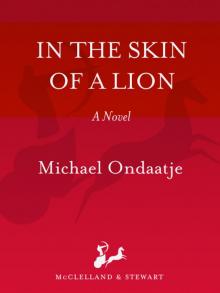 In the Skin of a Lion
In the Skin of a Lion The Cinnamon Peeler
The Cinnamon Peeler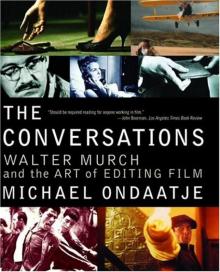 The Conversations: Walter Murch and the Art of Editing Film
The Conversations: Walter Murch and the Art of Editing Film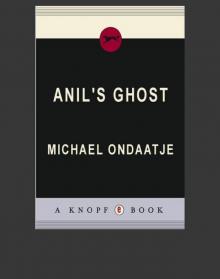 Anil's Ghost
Anil's Ghost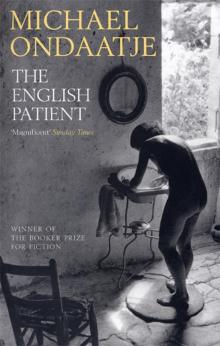 The English Patient
The English Patient Coming Through Slaughter
Coming Through Slaughter Handwriting
Handwriting Warlight
Warlight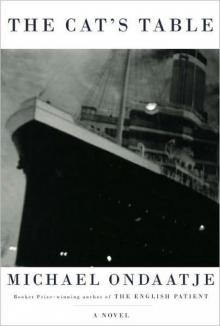 The Cat's Table
The Cat's Table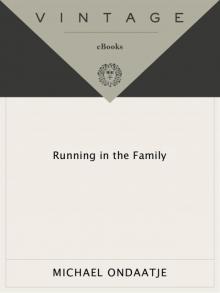 Running in the Family
Running in the Family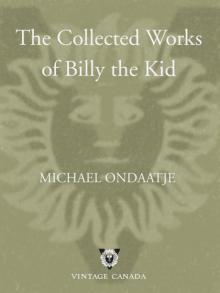 The Collected Works of Billy the Kid
The Collected Works of Billy the Kid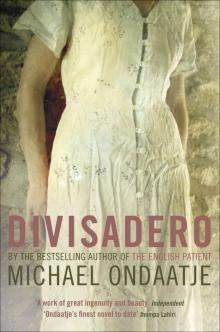 Divisadero
Divisadero